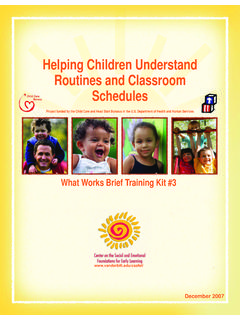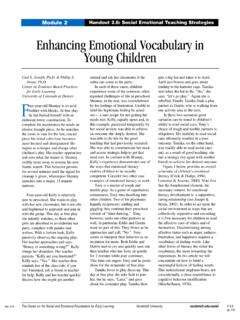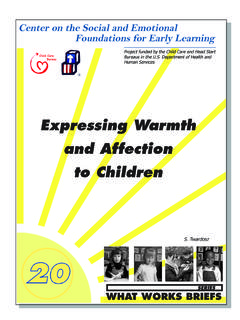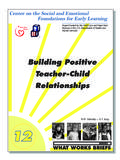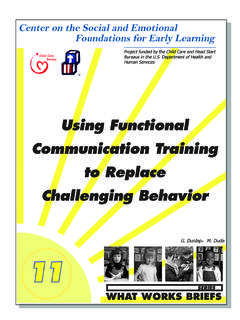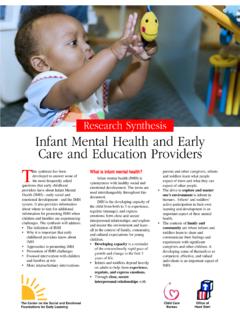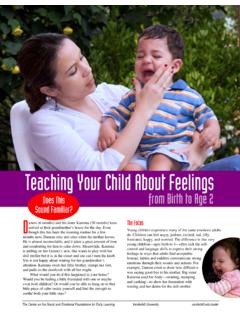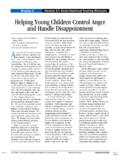Transcription of Helping Children Express Their Wants and Needs
1 Project funded by the Child Care and Head Start Bureaus in the Department of Health and Human ServicesHelping Children Express Their Wants and NeedsWhat Works Brief Training Kit #19 June 2009 What Works Brief Training Kits were developed to help in-service and pre-service providers conduct staff development activities. Each kit is based on one What Works Brief and contains the following items: presenter s PowerPoint note pages, participant handouts, activity ideas, pre-training survey, demographic form, training evaluation, and training certificate. The What Works Brief Training Kits are grounded in the Pyramid model depicted below which provides a framework for describing the four interrelated levels of practice that address the social and emotional development of all Children .
2 The Pyramid is designed to guide practitioners in understanding the importance of Children s social-emotional competence in terms of school readiness and the prevention of challenging behavior. This What Works Brief Training Kit relates to the Targeted Social Emotional Supports level of the Pyramid. We welcome your feedback as you provide professional development activities with these materials. Special thanks to the Meginnis Endowment at UIUC for funding to help support this effort and to the following individuals who developed the What Works Brief Training Kits materials: Micki Ostrosky, Hedda Meadan, Greg Cheatham, Monique Mills, Sallee Beneke, Nancy Gaumer, Amy Hayden, Elenor Rentschler, and Angel Notes:Presenter should be familiar with the content in What Works Brief #19 (available at ).
3 Welcome participants. Take care of any logistics ( , length of time for session, break, handouts, etc.).Consider using the What Works Brief #19 handout as a supplemental out the pre-training survey for all participants to complete and turn you present the workshop, remind participants to take the culture and background of Children into consideration and to work hand-in-hand with parents when they select target behaviors, since some behaviors may be part of the child s Training Kit #19 Helping Children Express Their Wants and NeedsPresenter PowerPointPresenter NotesActivity 1 Pair-Think-SharePair with a partnerIdentify some ways in which Children make Their Wants and Needs knownThink about how communication difficulties could affect this abilityShare your thoughtsSpeaker Notes:Assign participants to complete the chart on the Activity 1 thoughts with the large group by having some pairs share Their ideas.
4 Participants may share things like:Crying to request a toy to play with Hitting to take a conversational turn Throwing a temper tantrum to end an activity Grabbing to comment that s/he Wants someone/something Activity 1 Speaker Notes:Ask participants to think of and record three additional examples. want /NeedHow child meets want /needPossiblechallenging behaviorSnackPoint, askHit, cry, grab, screamCommunication and BehaviorCommunication the process of exchanging meaning between individualsChildren communicate in order to get Their Wants and Needs metIf communication skills are impaired, Children fail to get Their Wants and Needs metWhen Wants and Needs are not met, problem behavior increasesSpeaker Notes.
5 One can communicate by Talking Using body language ( , stance, distance from others), using gestures ( , pointing, reaching, or giving), making facial expressionsEstablishing and/or engaging in joint attention ( , sharing attention, directing the attention of another person, or following the attention of another person)Making vocalizations ( , grunts, cries) Shyness and extreme aggression may impair Children s ability to get Their Wants and Needs met. Children may have expressive (what they can Express /articulate) or receptive (what they can understand) communication disorders or delays. Children with communication disorders or delays often exhibit challenging behaviors when Their Needs are not met.
6 Additionally, communicative attempts are often misinterpreted by 2 Write down some various ways in which one or two Children whom you have served communicate. This will include things they say, gestures, body language, you noticed any cultural differences in communication style? Note those as well!Speaker Notes:Provide paper for participants to brainstorm the communication abilities of the Children they serve. Children from some cultures ( , African American, Hawaiian) may communicate using language varieties that can be misinterpreted by people who do not speak this language variety ( , She been here ( She has been playing with me for a long time and is still playing with me ) vs.)
7 She been here ( She was here but she s gone now ). Children from some cultures may be from homes where multiple conversations are taking place at one time. Therefore they may carry on a conversation while others have the floor. The English of bilingual students may be influenced by Their first language ( , The girl no can read follows spanish syntax: La nina no pueda leer ). students from cultures where it is inappropriate to look an authority figure in the eye may not make direct eye contact with Their Characteristics of Children with DisabilitiesChildren with communication disorders may display the following characteristics in multiple environments:Use of limited number of words Difficulty understanding concepts Problems following directions Displaying frustration when trying to communicateSpeaker Notes:It is necessary to collaborate with family members to see if the child s communication is impaired at home as well as school.
8 If not, then the child may simply be displaying language differences related to his/her culture, or language differences due to acquiring a second language or second That Facilitate Improved Communication SkillsReading a child s body language Providing a child with choices Providing picture schedules to help a child move easily between activitiesSegmenting multiple-step directions Providing cues to help a child better understand expectationsModeling target communication skillsSpeaker Notes:Check with family members or members of a child s speech community to determine what is culturally appropriate for the sure that strategies can easily be implemented in multiple settings ( , home, church, school, grocery store, etc).
9 Example strategies: Reading a child s body language. Providing choices: What would the child like to do first? Providing picture schedules. Simplifying complex or vague commands: Instead of It s time to go home, get your things, a teacher could say Go get your backpack. Put this newsletter in your backpack for Mom and Dad. Now get your coat. Providing cues: verbal ( , Turn on the water first ), pictorial/visual ( , showing a picture of a child turning on the water), nonverbal ( , demonstrating how to wash hands, pointing to the faucet when telling the child to turn on the water), or tactile ( , taking a child s hand and Helping him/her turn on the faucet). Modeling: Use words that the child Needs to know ( , more, help, toy, play, and juice ) as frequently as possible throughout the day.
10 Repetition across communicative contexts is key!Activity 3 Pair-Think-SharePair with a partnerIdentify one specific example of how you would implement each of the strategies listed in the lefthand columnThink about the impact it might have on a child s ability to make his/her Wants and Needs your thoughtsSpeaker Notes:Assign partners. Pairs should write a specific example of how they would implement each of the strategies listed on the lefthand column of the Activity 3 handout. Share thoughts with the large group by having some pairs share Their ideas. Example ideas to share:Reading a child s body language: Jesse turned to face the snack table whenever she was hungry.
